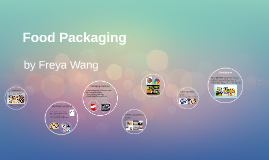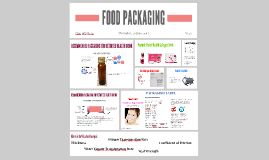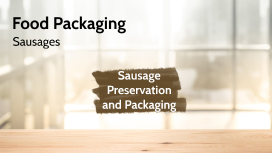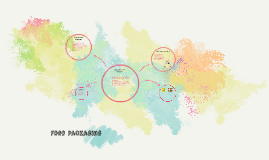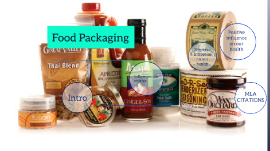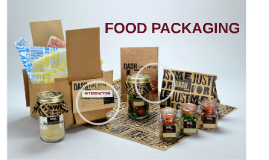FOOD PACKAGING
Transcript: Food Packaging Mirna Salem Intro into food packaging Intro Consumers today enjoy a wide array of food products from which to choose, but they also face a daunting challenge when trying to make healthful food choices. Packaging can influence consumer purchase decisions. When shopping for food, consumers face aisle after aisle of shelves filled with very similar products. Information from food industry reports and leaders indicates that consumers are spending less time on food shopping, making quick decisions at the shelf and placing great value on being able to get in and out of a store quickly. Product packaging is designed to influence those decisions. Influence on consumers decisions How does product packaging influence those decisions? Branding seeks to build, reinforce, and convey a product’s identity. Brands that are familiar, easily recognizable, and associated with positive attributes such as quality, value, health, or enjoyment generally have a competitive advantage over less recognizable brands (Aaker, 1991). On food packages, product images, names, slogans, symbols, logos, and licensed characters are all used to build, reinforce, or convey brand identity to consumers. Many packages also include product images or photographs that show the appearance of the food inside. Product claims include a wide range of messages, from descriptions of the product (e.g., “crispy toasted rice”) or how it is made (e.g., “organic”) to subjective evaluations (e.g., “delicious”) and nutrition-related claims. Nutrition claims can be structure/function claims (e.g., “calcium builds strong bones”), nutrient content claims (e.g., “zero calories” or “good source of vitamin C”), or health claims (e.g., “While many factors affect heart disease, diets low in saturated fats and cholesterol may reduce the risk of heart disease”). Promotions can include special offers (e.g., discounts, coupons), giveaways (e.g., toys, games), endorsements (e.g., from celebrities), partnerships (e.g., with professional sports leagues, hit movies), and sponsorships (e.g., of an event or for a cause) designed to increase product appeal to consumers. Products that use marketing methods Products that use those marketing methods are likely to be high in undesirable nutrients: An ad hoc committee identified evidence suggesting that a high percentage of food products bearing nutrition claims and other product information used in marketing are likely to be high in undesirable nutrients such as saturated and trans fats, sodium, and added sugars. Findings from these studies do not suggest that product packaging includes false claims that are in violation of food labeling regulations, rather that many packages containing foods high in undesirable nutrients include other claims about positive nutrient-related characteristics of the product. In other words, the package of a food high in fat would not claim it is low in fat, but might highlight that it is high in vitamin A. How packaging influences our choices: Promotional marketing on food packages may also influence consumer preferences and decisions. For example, research shows that a large majority (85 percent) of packaging targeting children uses cartoon-like graphics and typology (Elliott, 2008). To examine the effects of such on-package marketing, Roberto et al. (2010) had children ages 4-6 years taste and rate identical pairs of gummy fruit snacks, graham crackers, and carrots presented in packaging that did or did not include popular cartoon characters. After tasting both, children were also asked to select the product they would choose for a snack. Children preferred the taste of products that came in packages containing a cartoon character (Roberto et al., 2010). Influences our choices Proof#2 Study#2 In a randomized experiment, Kozup et al. (2003) examined consumer reactions to adding heart-healthy claims to packages of frozen lasagna dinner. Participants were 147 primary food shoppers who completed the study protocol online. Findings showed that those exposed to packages containing the claim reported significantly more favorable nutrition attitudes about the product than those who saw the same package without the label. These attitudes included judging the product to be “nutritious,” “good for your heart,” and “part of a healthy diet.” Negative influence on our health Negative influence on our health Chronic diseases, such as heart disease, cancer, stroke, and diabetes, are among the leading causes of death in the United States, accounting for at least 6 out of every 10 deaths each year (Kochanek et al., 2011) and placing a substantial burden on the nation’s healthcare spending (Schoenberg et al., 2007; Vogeli et al., 2007; Cunningham, 2009). The literature on epidemiological, clinical, and laboratory studies linking behavioral risk factors and mortality suggests that poor diet and lack of physical activity are strongly associated with mortality and may soon replace tobacco as a leading cause of An






